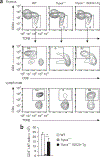The transcription factor ThPOK suppresses Runx3 and imposes CD4(+) lineage fate by inducing the SOCS suppressors of cytokine signaling
- PMID: 24880459
- PMCID: PMC6693509
- DOI: 10.1038/ni.2917
The transcription factor ThPOK suppresses Runx3 and imposes CD4(+) lineage fate by inducing the SOCS suppressors of cytokine signaling
Abstract
Lineage fate in the thymus is determined by mutually exclusive expression of the transcription factors ThPOK and Runx3, with ThPOK imposing the CD4(+) lineage fate and Runx3 promoting the CD8(+) lineage fate. While it is known that cytokine signals induce thymocytes to express Runx3, it is not known how ThPOK prevents thymocytes from expressing Runx3 and adopting the CD8(+) lineage fate, nor is it understood why ThPOK itself imposes the CD4(+) lineage fate on thymocytes. We now report that genes encoding members of the SOCS (suppressor of cytokine signaling) family are critical targets of ThPOK and that their induction by ThPOK represses Runx3 expression and promotes the CD4(+) lineage fate. Thus, induction of SOCS-encoding genes is the main mechanism by which ThPOK imposes the CD4(+) lineage fate in the thymus.
Conflict of interest statement
COMPETING FINANCIAL INTERESTS
The authors declare no competing financial interests.
Figures







Similar articles
-
Thpok-independent repression of Runx3 by Gata3 during CD4+ T-cell differentiation in the thymus.Eur J Immunol. 2013 Apr;43(4):918-28. doi: 10.1002/eji.201242944. Epub 2013 Feb 12. Eur J Immunol. 2013. PMID: 23310955 Free PMC article.
-
The CD4/CD8 lineages: central decisions and peripheral modifications for T lymphocytes.Curr Top Microbiol Immunol. 2014;373:113-29. doi: 10.1007/82_2013_323. Curr Top Microbiol Immunol. 2014. PMID: 23612990 Review.
-
Coreceptor gene imprinting governs thymocyte lineage fate.EMBO J. 2012 Jan 18;31(2):366-77. doi: 10.1038/emboj.2011.388. Epub 2011 Oct 28. EMBO J. 2012. PMID: 22036949 Free PMC article.
-
Analyzing expression of perforin, Runx3, and Thpok genes during positive selection reveals activation of CD8-differentiation programs by MHC II-signaled thymocytes.J Immunol. 2005 Oct 1;175(7):4465-74. doi: 10.4049/jimmunol.175.7.4465. J Immunol. 2005. PMID: 16177089
-
CD4 CTL: living up to the challenge.Semin Immunol. 2013 Nov 15;25(4):273-81. doi: 10.1016/j.smim.2013.10.022. Epub 2013 Nov 15. Semin Immunol. 2013. PMID: 24246226 Free PMC article. Review.
Cited by
-
Harnessing the Power of IL-7 to Boost T Cell Immunity in Experimental and Clinical Immunotherapies.Immune Netw. 2024 Feb 15;24(1):e9. doi: 10.4110/in.2024.24.e9. eCollection 2024 Feb. Immune Netw. 2024. PMID: 38455462 Free PMC article. Review.
-
Negative Regulation of Cytokine Signaling in Immunity.Cold Spring Harb Perspect Biol. 2018 Jul 2;10(7):a028571. doi: 10.1101/cshperspect.a028571. Cold Spring Harb Perspect Biol. 2018. PMID: 28716890 Free PMC article. Review.
-
NFAT1 and NFAT2 Differentially Regulate CTL Differentiation Upon Acute Viral Infection.Front Immunol. 2019 Feb 15;10:184. doi: 10.3389/fimmu.2019.00184. eCollection 2019. Front Immunol. 2019. PMID: 30828328 Free PMC article.
-
Arsenic exposure impels CD4 commitment in thymus and suppress T cell cytokine secretion by increasing regulatory T cells.Sci Rep. 2017 Aug 2;7(1):7140. doi: 10.1038/s41598-017-07271-z. Sci Rep. 2017. PMID: 28769045 Free PMC article.
-
Mechanisms and consequences of Jak-STAT signaling in the immune system.Nat Immunol. 2017 Mar 22;18(4):374-384. doi: 10.1038/ni.3691. Nat Immunol. 2017. PMID: 28323260 Free PMC article. Review.
References
-
- He X et al. The zinc finger transcription factor Th-POK regulates CD4 versus CD8 T-cell lineage commitment. Nature 433, 826–833 (2005). - PubMed
-
- Sun G et al. The zinc finger protein cKrox directs CD4 lineage differentiation during intrathymic T cell positive selection. Nat. Immunol 6, 373–381 (2005). - PubMed
-
- Sato T et al. Dual functions of Runx proteins for reactivating CD8 and silencing CD4 at the commitment process into CD8 thymocytes. Immunity 22, 317–328 (2005). - PubMed
-
- Taniuchi I et al. Differential requirements for Runx proteins in CD4 repression and epigenetic silencing during T lymphocyte development. Cell 111, 621–633 (2002). - PubMed
Publication types
MeSH terms
Substances
Grants and funding
LinkOut - more resources
Full Text Sources
Other Literature Sources
Molecular Biology Databases
Research Materials

